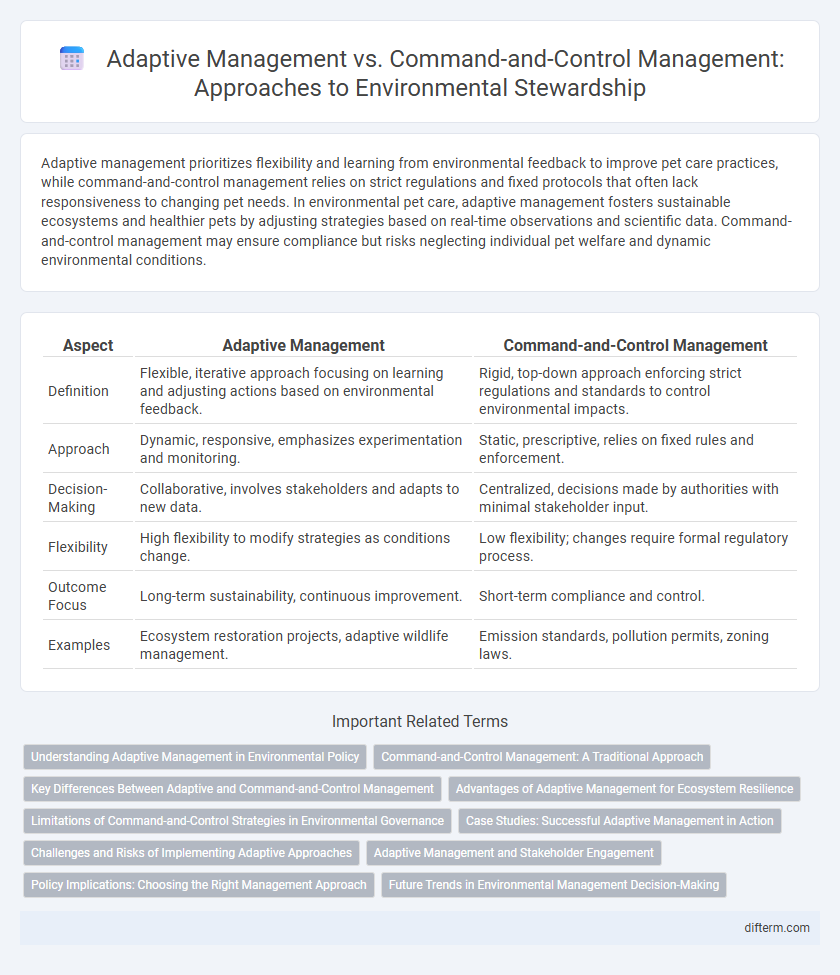Adaptive management prioritizes flexibility and learning from environmental feedback to improve pet care practices, while command-and-control management relies on strict regulations and fixed protocols that often lack responsiveness to changing pet needs. In environmental pet care, adaptive management fosters sustainable ecosystems and healthier pets by adjusting strategies based on real-time observations and scientific data. Command-and-control management may ensure compliance but risks neglecting individual pet welfare and dynamic environmental conditions.
Table of Comparison
| Aspect | Adaptive Management | Command-and-Control Management |
|---|---|---|
| Definition | Flexible, iterative approach focusing on learning and adjusting actions based on environmental feedback. | Rigid, top-down approach enforcing strict regulations and standards to control environmental impacts. |
| Approach | Dynamic, responsive, emphasizes experimentation and monitoring. | Static, prescriptive, relies on fixed rules and enforcement. |
| Decision-Making | Collaborative, involves stakeholders and adapts to new data. | Centralized, decisions made by authorities with minimal stakeholder input. |
| Flexibility | High flexibility to modify strategies as conditions change. | Low flexibility; changes require formal regulatory process. |
| Outcome Focus | Long-term sustainability, continuous improvement. | Short-term compliance and control. |
| Examples | Ecosystem restoration projects, adaptive wildlife management. | Emission standards, pollution permits, zoning laws. |
Understanding Adaptive Management in Environmental Policy
Adaptive management in environmental policy emphasizes learning through iterative decision-making, allowing policies to evolve based on ecosystem responses and new scientific data. This approach contrasts with command-and-control management, which relies on fixed regulations and prescriptive measures, often limiting flexibility in dynamic environmental conditions. Embracing adaptive management enhances resilience by integrating ecological uncertainty and stakeholder feedback into continuous policy refinement.
Command-and-Control Management: A Traditional Approach
Command-and-control management is a traditional environmental regulation approach that imposes specific limits and standards on pollution emissions, often through legal mandates and penalties. This method relies on centralized authority to enforce compliance, setting fixed rules that industries must follow to reduce environmental harm. Despite its clear regulatory framework, command-and-control management can lack flexibility and responsiveness to changing ecological conditions compared to adaptive management strategies.
Key Differences Between Adaptive and Command-and-Control Management
Adaptive management emphasizes continuous learning and flexibility by integrating monitoring and feedback to adjust environmental strategies, whereas command-and-control management relies on fixed regulations and strict enforcement. Adaptive management fosters stakeholder participation and iterative decision-making to respond to ecological uncertainties, while command-and-control focuses on prescriptive rules and top-down governance. The key difference lies in adaptive management's dynamic approach allowing evolution over time versus command-and-control's static, rigid framework.
Advantages of Adaptive Management for Ecosystem Resilience
Adaptive management enhances ecosystem resilience by enabling flexible responses to environmental variability and uncertainties, promoting learning through continuous monitoring and feedback. It supports the incorporation of new scientific data and stakeholder input, leading to more informed decision-making that can adjust to changing ecological conditions. This approach reduces the risks of rigid, one-size-fits-all policies typical of command-and-control management, fostering sustainable ecosystem function and biodiversity conservation.
Limitations of Command-and-Control Strategies in Environmental Governance
Command-and-control management in environmental governance often suffers from rigidity, failing to adapt to dynamic ecological systems and evolving environmental conditions. This approach relies heavily on prescriptive regulations and penalties, which can lead to enforcement challenges and limited stakeholder engagement. These limitations reduce the effectiveness of command-and-control strategies in achieving sustainable environmental outcomes compared to more flexible adaptive management frameworks.
Case Studies: Successful Adaptive Management in Action
Case studies of successful adaptive management highlight the flexibility and learning-oriented approach that contrasts with rigid command-and-control management. In ecosystems such as the Everglades restoration project and the Yellowstone National Park wolf reintroduction, adaptive management allowed for iterative decision-making based on ongoing monitoring and feedback, leading to improved ecological outcomes. These cases demonstrate how embracing uncertainty and stakeholder collaboration enhances resilience and sustainability in environmental management.
Challenges and Risks of Implementing Adaptive Approaches
Adaptive management faces challenges including uncertainty in ecosystem responses, limited long-term data, and the need for continuous monitoring and flexible decision-making frameworks. Risks involve potential delays in addressing urgent environmental issues and the possibility of resource misallocation due to iterative learning processes. Implementing adaptive approaches demands institutional commitment, stakeholder engagement, and robust feedback mechanisms to effectively adjust management strategies over time.
Adaptive Management and Stakeholder Engagement
Adaptive management emphasizes continuous learning and flexibility in environmental decision-making, allowing policies to adjust based on monitoring and feedback. Engaging stakeholders throughout the process ensures diverse perspectives and local knowledge are integrated, enhancing the effectiveness and legitimacy of management actions. This collaborative approach supports ecosystem resilience and sustainable resource use by fostering shared responsibility and adaptive capacity.
Policy Implications: Choosing the Right Management Approach
Adaptive management fosters flexibility by incorporating continuous learning and feedback loops, making it well-suited for dynamic environmental systems and uncertainty. Command-and-control management offers clear, enforceable regulations that ensure compliance but may lack responsiveness to ecological variability. Policymakers must weigh the trade-offs between adaptive management's versatility and command-and-control's rigidity to design effective environmental policies that balance sustainability and regulatory certainty.
Future Trends in Environmental Management Decision-Making
Future trends in environmental management emphasize adaptive management as a dynamic approach capable of responding to ecological uncertainties through continuous learning and flexible policies. Command-and-control management, characterized by rigid regulations and fixed standards, is increasingly supplemented by adaptive frameworks that integrate real-time data and stakeholder collaboration. Advancements in environmental monitoring technologies and data analytics will further empower adaptive strategies, driving more resilient and effective decision-making in ecosystem conservation and resource management.
adaptive management vs command-and-control management Infographic

 difterm.com
difterm.com